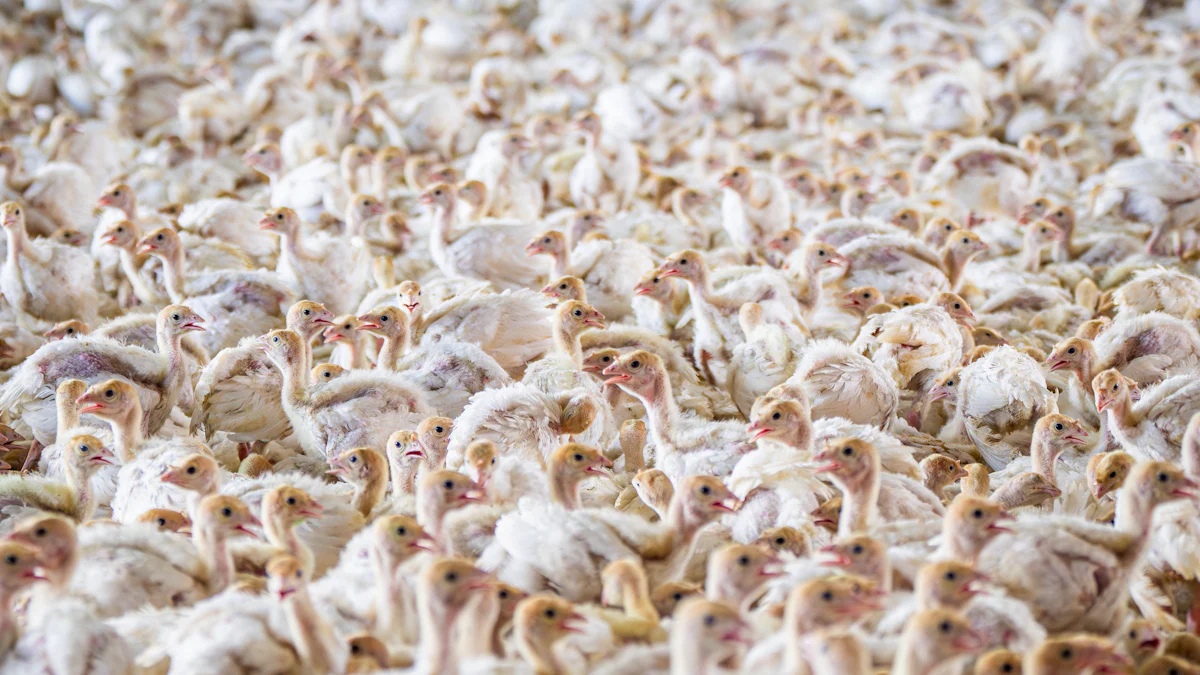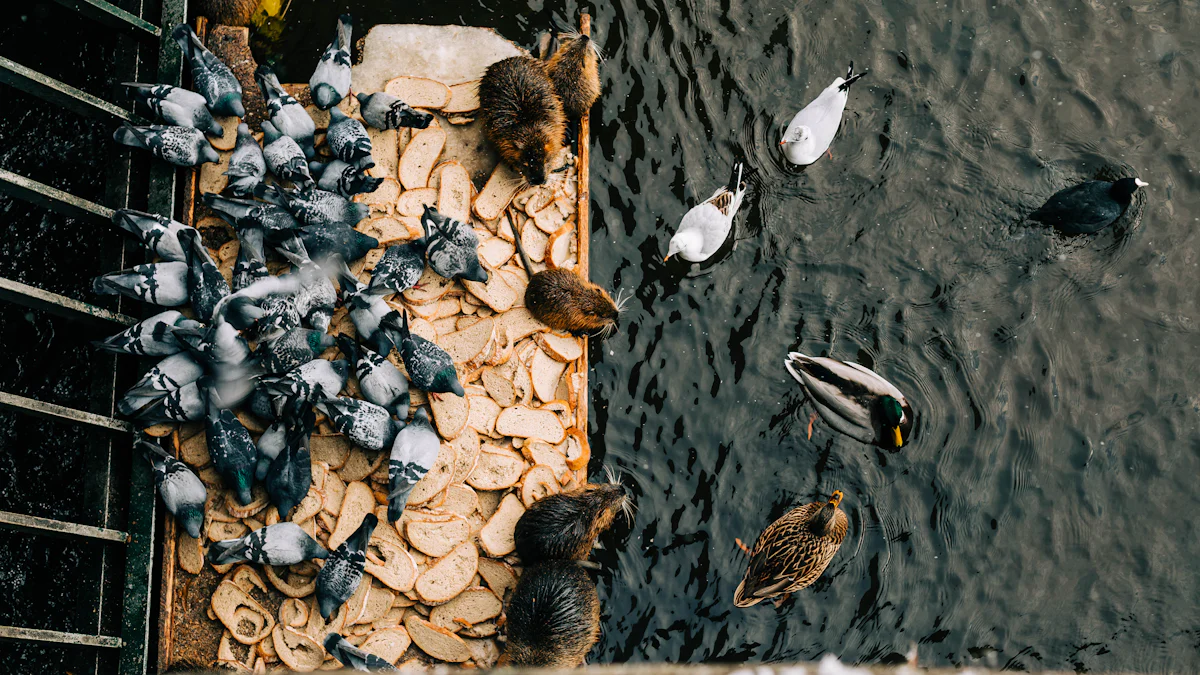
Raising mealworms for chickens is easier than you might think. These tiny, wriggling creatures pack a punch of protein and nutrients that can boost your flock’s health. You don’t need fancy equipment or a lot of space to get started with mealworms for chickens. With just a few simple materials, you can create a sustainable source of treats that your chickens will love. Plus, watching the mealworm life cycle unfold can be a fun and educational experience for you and your family.
Key Takeaways
- Mealworms are a nutritious treat for chickens, packed with protein and essential nutrients that enhance their health and egg production.
- Raising mealworms at home is cost-effective and sustainable, allowing you to save money on store-bought treats while reducing kitchen waste.
- Starting a mealworm farm requires minimal materials: a container, organic substrate, starter mealworms, and moisture sources like vegetables.
- Maintaining a clean and well-ventilated environment is crucial for the health of your mealworms; regular cleaning prevents mold and ensures a thriving farm.
- Understanding the mealworm life cycle helps you manage your farm effectively, ensuring a continuous supply of mealworms for your chickens.
- Involve your family in the process; raising mealworms can be a fun and educational activity that connects you with your flock.
- With proper care and attention, your mealworm farm will provide a steady source of nutritious treats, leading to healthier and happier chickens.
Why Raise Mealworms for Chickens?
Raising mealworms for chickens offers more than just a fun project. It’s a practical way to improve your flock’s diet, save money, and enjoy a sustainable hobby. Let’s dive into why mealworms for chickens are such a great idea.
Nutritional Benefits of Mealworms for Chickens
Mealworms are packed with protein, which is essential for your chickens’ growth, egg production, and overall health. They also contain healthy fats and important nutrients like potassium and iron. These nutrients help keep your chickens active, strong, and happy. By adding mealworms to their diet, you’re giving them a boost that commercial feeds alone might not provide. Plus, chickens love the taste, so it’s a treat they’ll eagerly gobble up.
Cost-Effective and Sustainable Chicken Treat
Store-bought chicken treats can get expensive over time. Raising mealworms at home saves you money while ensuring a steady supply of high-quality snacks for your flock. Mealworms reproduce quickly, so once you start, you’ll have an ongoing source of treats without constantly buying more. It’s also a sustainable option. You can use kitchen scraps like vegetable peels to feed your mealworms, reducing waste and creating a closed-loop system that benefits both your chickens and the environment.
Easy and Fun for Beginners and Families
Starting a mealworm farm doesn’t require special skills or expensive equipment. You only need a container, some substrate, and starter mealworms to get going. The process is simple enough for beginners, and it’s a great activity to involve your family. Watching the mealworms grow and transform through their life cycle can be fascinating for kids and adults alike. It’s not just about feeding your chickens—it’s about learning and having fun along the way.
“Raising mealworms is a win-win for you and your chickens. It’s easy, affordable, and rewarding.”
Mealworms for chickens aren’t just a treat—they’re a way to connect with your flock and make their care more sustainable. Whether you’re looking to save money, improve your chickens’ health, or try something new, mealworms are a fantastic choice.
What You Need to Get Started

Starting your mealworm farm doesn’t require much. With a few basic materials and the right setup, you’ll be on your way to providing a nutritious treat for your chickens. Let’s break down what you need to get started.
Essential Materials and Tools
To raise mealworms successfully, you’ll need a few key items. These materials are easy to find and affordable, making this project accessible for anyone.
A container or bin with proper ventilation
Choose a container that’s at least 6 inches deep. Plastic bins or drawers work well. Drill small holes in the lid or sides to allow airflow. Proper ventilation prevents mold and keeps your mealworms healthy. Avoid containers without lids, as they might let pests or curious chickens get inside.
Organic substrate like oats or wheat bran
The substrate acts as bedding and food for your mealworms. Use organic oats, wheat bran, or a mix of both. Spread about 2-3 inches of substrate in the container. This layer will provide a comfortable environment for your mealworms to thrive.
Starter mealworms (larvae)
You’ll need live mealworms to begin your farm. Purchase them from a pet store, online supplier, or even a local farm. Start with a small batch, such as 500 to 1,000 larvae. They’ll multiply quickly, so you won’t need to buy more once your farm is established.
Moisture sources like carrots or potatoes
Mealworms need moisture to stay hydrated. Add slices of carrots, potatoes, or other vegetables to the container. Replace them every few days to prevent mold. Avoid overloading the container with moisture sources, as too much can create a damp environment.
Choosing the Best Location
Where you place your mealworm farm matters. The right location ensures your mealworms grow and reproduce efficiently.
Warm, dry, and dark environment
Mealworms thrive in warm temperatures between 70°F and 75°F. Keep the container in a dry, dark spot like a closet, pantry, or garage. Avoid direct sunlight, as it can overheat the container. A stable environment helps your mealworms stay active and healthy.
Avoiding extreme temperatures and humidity
Extreme heat or cold can harm your mealworms. If the temperature drops too low, their growth slows down. High humidity can lead to mold and other issues. Monitor the conditions in your chosen location to maintain an ideal environment.
“A little preparation goes a long way. With the right tools and setup, you’ll have a thriving mealworm farm in no time.”
By gathering these materials and setting up your farm in the right spot, you’re setting yourself up for success. Raising mealworms for chickens is simple when you start with a solid foundation. Your chickens will thank you for the effort!
Step-by-Step Guide to Raising Mealworms for Chickens
Setting Up Your Mealworm Farm
Preparing the container and adding substrate
Start by choosing a container that’s at least 6 inches deep. Plastic bins or drawers work great. Drill small holes in the lid or sides to allow airflow. Ventilation is key to preventing mold and keeping your mealworms healthy. Once your container is ready, add 2-3 inches of organic substrate like oats or wheat bran. Spread it evenly across the bottom. This substrate will serve as both bedding and food for your mealworms.
Introducing mealworm larvae
Now it’s time to introduce your starter mealworms. Gently place them on top of the substrate. They’ll burrow into it naturally. Start with 500 to 1,000 mealworms to give your farm a solid foundation. Avoid overcrowding the container, as this can lead to stress and slower growth. Once they’re settled, your mealworms will begin their life cycle and start reproducing.
Feeding and Caring for Mealworms
Providing food and moisture
Mealworms need a steady supply of food and moisture to thrive. Add slices of carrots, potatoes, or other vegetables to the container. These provide hydration and prevent your mealworms from drying out. Replace the vegetables every few days to keep the environment fresh. For food, the substrate itself—oats or wheat bran—will suffice. Check regularly to ensure your mealworms have enough to eat.
Maintaining cleanliness and preventing mold
A clean environment is essential for healthy mealworms. Remove any uneaten vegetables before they rot. Mold can harm your mealworms and ruin your farm. If you notice any damp spots in the substrate, replace that portion immediately. Keep the container dry and well-ventilated to avoid issues. Regular maintenance will keep your mealworm farm running smoothly.
Monitoring the Mealworm Life Cycle
Understanding the stages: larvae, pupae, beetles
Mealworms go through four stages: egg, larvae, pupae, and beetle. The larvae are the mealworms you’ll feed to your chickens. Over time, some larvae will transform into pupae, which don’t move or eat. These pupae eventually become beetles. The beetles lay eggs, starting the cycle again. Understanding this process helps you manage your farm effectively.
Ensuring a continuous supply of mealworms
To keep your farm productive, separate the beetles from the larvae once they appear. Use a second container for the beetles to lay eggs. This prevents them from eating the larvae and ensures a steady supply of mealworms for your chickens. Rotate the beetles between containers every few weeks to maximize egg production. With proper care, your farm will provide a continuous source of mealworms for chicken treats.
“Consistency is key. A little daily attention keeps your mealworm farm thriving.”
By following these steps, you’ll create a sustainable system that benefits both you and your flock. Raising mealworms for chickens doesn’t just save money—it’s a rewarding way to connect with your animals and provide them with nutritious treats.
Harvesting Mealworms for Chickens
Collecting mealworms safely
When it’s time to harvest mealworms, you’ll want to do it carefully to keep your farm thriving. Start by scooping out the mealworms from the substrate using a small sieve or strainer. Gently shake the sieve to separate the mealworms from the bedding. This method ensures you don’t accidentally remove eggs or pupae, which are essential for maintaining your farm’s cycle.
If you notice beetles or pupae mixed in with the mealworms, place them back into the container. They play a crucial role in reproduction and keeping your farm productive. Always handle the mealworms with clean hands or tools to avoid introducing bacteria or contaminants. Keeping the process clean protects both your mealworms and your chickens.
“Harvesting mealworms doesn’t have to be complicated. A little care goes a long way in keeping your farm healthy.”
Storing mealworms before feeding
Once you’ve collected your mealworms, proper storage is key. If you plan to feed them to your chickens right away, place the mealworms in a shallow dish or container. Chickens love live mealworms, so offering them fresh ensures they get the most nutrition and enjoyment.
For short-term storage, keep the mealworms in a breathable container with a small amount of substrate. Store them in a cool, dry place to slow their activity. If you need to store them longer, refrigerate them at around 40°F. The cold temperature will put the mealworms into a dormant state, extending their shelf life. Avoid freezing them, as this can kill the mealworms and reduce their nutritional value.
Before feeding refrigerated mealworms to your chickens, let them warm up to room temperature. This step ensures your chickens enjoy an active and lively treat. By storing mealworms properly, you’ll always have a nutritious snack ready for your flock.
“Fresh or stored, mealworms are a fantastic way to keep your chickens happy and healthy.”
Tips for Success with Mealworms for Chickens
Avoiding Common Mistakes
Preventing overcrowding and managing moisture
Overcrowding can quickly turn your mealworm farm into a stressful environment. Too many mealworms in one container leads to competition for food and space, which slows their growth. To avoid this, monitor the population regularly. If the container starts looking crowded, transfer some mealworms to a new bin. This simple step keeps them comfortable and productive.
Moisture management is equally important. Excess moisture creates a breeding ground for mold, which can harm your mealworms. Always use just enough vegetables, like carrots or potatoes, to provide hydration without soaking the substrate. Replace these moisture sources every few days to keep the environment fresh. If you notice damp spots in the bedding, remove and replace them immediately. A dry, well-ventilated setup ensures your mealworms stay healthy.
“A little attention to space and moisture goes a long way in keeping your mealworm farm thriving.”
Maximizing Mealworm Production
Rotating beetles and using multiple bins
To boost mealworm production, focus on managing the beetles effectively. Beetles lay eggs that eventually become mealworms, so keeping them active is key. Rotate the beetles between containers every few weeks. This practice prevents overcrowding and gives the eggs a safe space to hatch without interference.
Using multiple bins also helps. Dedicate one bin for beetles and another for larvae. This separation ensures the beetles don’t accidentally eat the eggs or larvae. With this system, you’ll maintain a steady cycle of mealworm growth. By rotating and organizing your bins, you’ll maximize production and always have a fresh supply of mealworms for your chickens.
Keeping Your Mealworm Farm Healthy
Regular cleaning and removing waste
A clean farm is a healthy farm. Over time, mealworms produce waste, known as frass, which can build up in the substrate. Too much waste affects the air quality and creates an unhealthy environment. To prevent this, sift through the substrate every few weeks to remove frass. Use a fine mesh strainer to separate the waste from the mealworms and bedding.
Also, check for any spoiled vegetables or moldy spots during cleaning. Remove these immediately to avoid contamination. Regular maintenance keeps your farm running smoothly and ensures your mealworms remain healthy and productive. A little effort in cleaning goes a long way in maintaining a thriving mealworm farm.
“Consistency in cleaning and care keeps your mealworm farm in top shape.”
By following these tips, you’ll create a successful and sustainable system for raising mealworms for chickens. With proper care, your farm will provide a continuous supply of nutritious treats that your flock will love.
Raising mealworms for chickens is a simple and rewarding way to improve your flock’s diet. With just a few materials and some basic care, you can create a sustainable source of protein-packed treats. Your chickens will love the fresh, nutritious mealworms, and you’ll enjoy the satisfaction of providing for them in an eco-friendly way. Starting your mealworm farm today means healthier, happier chickens tomorrow. Why wait? Dive into this fun and cost-effective project and see the difference it makes for your flock.
FAQ
How long does it take to start seeing mealworms in my farm?
You’ll start noticing mealworms within a few weeks. The exact time depends on the temperature and care you provide. Warmer conditions (around 70°F to 75°F) speed up their life cycle. With proper setup and maintenance, your farm will become productive quickly.
Do I need to clean the container often?
Yes, regular cleaning is essential. Every few weeks, sift through the substrate to remove waste (frass) and any spoiled vegetables. Keeping the environment clean prevents mold and ensures your mealworms stay healthy. A clean farm also helps maintain a steady supply of mealworms.
Can I use any type of container for raising mealworms?
Not all containers work well. Choose one that’s at least 6 inches deep and has proper ventilation. Plastic bins or drawers are ideal. Drill small holes in the lid or sides for airflow. Avoid containers without lids, as they can let pests or curious pets get inside.
What should I do if I see mold in the container?
Remove the moldy section immediately. Mold can harm your mealworms and ruin the substrate. Replace the affected area with fresh substrate. To prevent mold, ensure proper ventilation and avoid adding too much moisture to the container.
How many mealworms should I start with?
Starting with 500 to 1,000 mealworms is a good idea. This number gives your farm a solid foundation. Mealworms reproduce quickly, so you won’t need to buy more once your farm is established. If you’re new to this, starting small makes it easier to manage.
Can I feed mealworms to my chickens every day?
Yes, but moderation is key. Mealworms are a treat, not a replacement for their regular feed. Offer them as a supplement to your chickens’ diet. A handful of mealworms a few times a week is enough to keep your flock happy and healthy.
What happens if the temperature drops too low?
Low temperatures slow down the mealworm life cycle. If it gets too cold, mealworms may stop growing or reproducing. Keep the container in a warm spot, ideally between 70°F and 75°F. If needed, move the farm indoors during colder months.
Do mealworms smell bad?
No, a well-maintained mealworm farm doesn’t smell bad. Any unpleasant odor usually comes from spoiled vegetables or mold. Regular cleaning and proper ventilation keep the farm odor-free. If you notice a smell, check for and remove any rotting food or waste.
Can I use kitchen scraps to feed my mealworms?
Yes, but stick to vegetable scraps like carrot peels or potato slices. Avoid adding anything too wet or prone to rotting, like fruit. Kitchen scraps can provide moisture and nutrition for your mealworms while reducing waste in your home.
How do I know when it’s time to harvest mealworms?
Harvest mealworms when they reach their full size, which usually takes a few weeks. Use a sieve to separate them from the substrate. If you see pupae or beetles, leave them in the container to continue the life cycle. Regular harvesting ensures a steady supply for your chickens.
“Raising mealworms becomes easier with time. The more you practice, the better you’ll get at managing your farm.”


